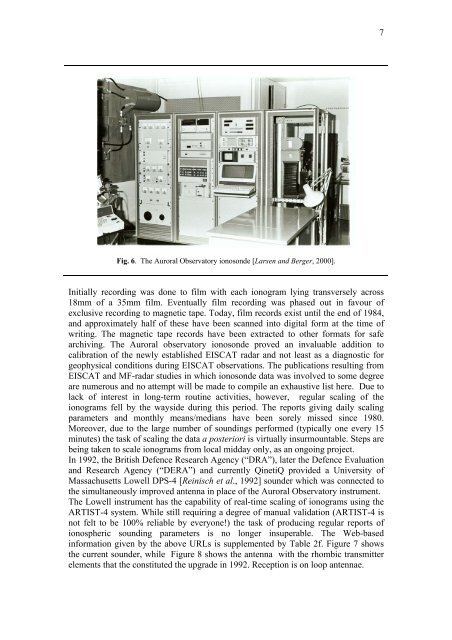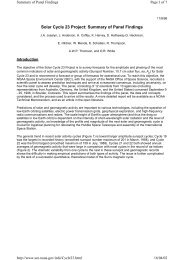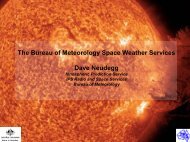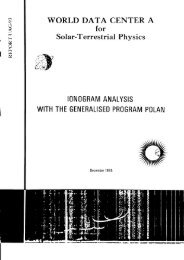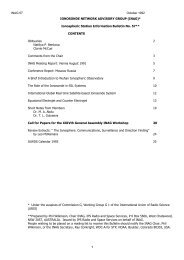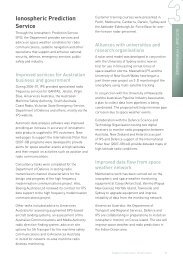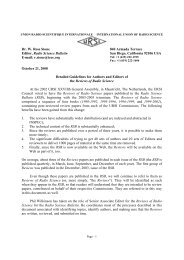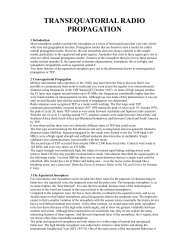20th Century operation of the Tromsø Ionosonde - IPS - Radio and ...
20th Century operation of the Tromsø Ionosonde - IPS - Radio and ...
20th Century operation of the Tromsø Ionosonde - IPS - Radio and ...
Create successful ePaper yourself
Turn your PDF publications into a flip-book with our unique Google optimized e-Paper software.
Fig. 6. The Auroral Observatory ionosonde [Larsen <strong>and</strong> Berger, 2000].<br />
Initially recording was done to film with each ionogram lying transversely across<br />
18mm <strong>of</strong> a 35mm film. Eventually film recording was phased out in favour <strong>of</strong><br />
exclusive recording to magnetic tape. Today, film records exist until <strong>the</strong> end <strong>of</strong> 1984,<br />
<strong>and</strong> approximately half <strong>of</strong> <strong>the</strong>se have been scanned into digital form at <strong>the</strong> time <strong>of</strong><br />
writing. The magnetic tape records have been extracted to o<strong>the</strong>r formats for safe<br />
archiving. The Auroral observatory ionosonde proved an invaluable addition to<br />
calibration <strong>of</strong> <strong>the</strong> newly established EISCAT radar <strong>and</strong> not least as a diagnostic for<br />
geophysical conditions during EISCAT observations. The publications resulting from<br />
EISCAT <strong>and</strong> MF-radar studies in which ionosonde data was involved to some degree<br />
are numerous <strong>and</strong> no attempt will be made to compile an exhaustive list here. Due to<br />
lack <strong>of</strong> interest in long-term routine activities, however, regular scaling <strong>of</strong> <strong>the</strong><br />
ionograms fell by <strong>the</strong> wayside during this period. The reports giving daily scaling<br />
parameters <strong>and</strong> monthly means/medians have been sorely missed since 1980.<br />
Moreover, due to <strong>the</strong> large number <strong>of</strong> soundings performed (typically one every 15<br />
minutes) <strong>the</strong> task <strong>of</strong> scaling <strong>the</strong> data a posteriori is virtually insurmountable. Steps are<br />
being taken to scale ionograms from local midday only, as an ongoing project.<br />
In 1992, <strong>the</strong> British Defence Research Agency (“DRA”), later <strong>the</strong> Defence Evaluation<br />
<strong>and</strong> Research Agency (“DERA”) <strong>and</strong> currently QinetiQ provided a University <strong>of</strong><br />
Massachusetts Lowell DPS-4 [Reinisch et al., 1992] sounder which was connected to<br />
<strong>the</strong> simultaneously improved antenna in place <strong>of</strong> <strong>the</strong> Auroral Observatory instrument.<br />
The Lowell instrument has <strong>the</strong> capability <strong>of</strong> real-time scaling <strong>of</strong> ionograms using <strong>the</strong><br />
ARTIST-4 system. While still requiring a degree <strong>of</strong> manual validation (ARTIST-4 is<br />
not felt to be 100% reliable by everyone!) <strong>the</strong> task <strong>of</strong> producing regular reports <strong>of</strong><br />
ionospheric sounding parameters is no longer insuperable. The Web-based<br />
information given by <strong>the</strong> above URLs is supplemented by Table 2f. Figure 7 shows<br />
<strong>the</strong> current sounder, while Figure 8 shows <strong>the</strong> antenna with <strong>the</strong> rhombic transmitter<br />
elements that <strong>the</strong> constituted <strong>the</strong> upgrade in 1992. Reception is on loop antennae.<br />
7


